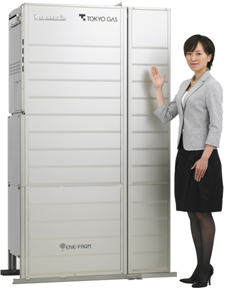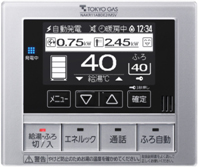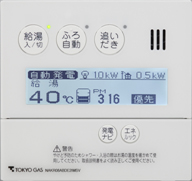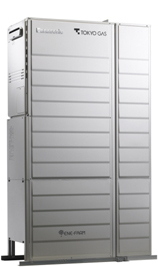Feb 09, 2011
- Tokyo Gas Co., Ltd.
- Panasonic Corporation
Press Release
Tokyo Gas and Panasonic to Launch New Improved "Ene-Farm" Home Fuel Cell with World-Highest*1 Power Generation Efficiency at More Affordable Price
Tokyo, Japan - Tokyo Gas Co., Ltd. and Panasonic Corporation have jointly developed a new model of their "Ene-Farm" home fuel cell. The new product is manufactured by Panasonic, and will be sold by Tokyo Gas from April 1, 2011.
The "Ene-Farm" fuel cell co-generation systems generate electricity through a chemical reaction between oxygen in the atmosphere and hydrogen extracted from city gas, and the heat generated as a byproduct of this process is also used for home heating and hot water supply. This system is extremely eco-friendly. Since the electricity is generated and used at the same place, there are no losses in transmission. Also, all heat produced during electricity generation can be used without waste. Compared to conventional method of using electricity from thermal power plant and hot water supply and heating using city gas*2, the fuel cell system allows primary energy consumption to be reduced by approximately 35%*3 and CO2 emissions by approximately 48%. Users can cut around 50,000-60,000 yen from annual utility bills, and CO2 emissions by approximately 1.5 tons*4 a year.
The new "Ene-Farm" fuel cell offers a rated generation efficiency of 40% (LHV)*5, representing a further improvement on the existing range of products with over 37% (LHV) efficiency, the highest in the world to date. The system configuration of "fuel cell unit" has been greatly simplified and the core components such as the "stacks" which generate electricity have been significantly downsized. These cost-saving efforts have allowed Tokyo Gas and Panasonic to significantly lower the recommended retail price of the new system to 2,761,500 yen (including tax; excluding installation fee), a saving of as much as around 700,000 yen compared to the current models.
Since the launch of the world's first "Ene-Farm" products in May 2009 through January 2011, Panasonic has shipped a total of approximately 5,000 units throughout Japan, of which approximately 4,000 have been sold by Tokyo Gas. For Fiscal Year 2012 ending in March 2012 (FY2012), Panasonic will set up a production system to expand the annual capacity more than 6,000 units*6, double its production estimate for FY2011. At the same time, Tokyo Gas will aim for annual sales of 5,000 units, double the FY2011 sales target of 2,500 units.
Through the spread of these "Ene-Farm" products, the two companies will contribute to bringing greater comfort to their customers' lives as well as helping to protect the global environment.
[Product exterior]

*2: Method where electricity is supplied from a thermal power station, and gas supplied by Tokyo Gas is used for heating. Assuming use of gas-based water boiler, gas-based floor heating (living room), and electrical air-conditioners for heating/cooling all rooms bar living room.
*3: Compared with the method (*2) at a rated operation of electricity generation of 0.75kWh and heat recovery volume of 0.94kWh / approximately 32 liters at 40 degrees Celsius.
*4: Conditions used in estimation are as follows:
- 4-person family in single, detached house (total floor area: 150m2).
- Annual burden - Hot water supply: 15.4GJ; Warming bath water: 1.7GJ; Cooking: 2.2GJ; Coolers: 3.1GJ; Floor heaters: 12.6GJ; Air-conditioner heating: 8.8GJ; Lighting and others: 16.8GJ
- CO2 equivalent - City gas: 2.29kg-CO2/m3; Electricity: 0.69kg-CO2/kWh
- Primary energy equivalent - Electricity: 9.76MJ/kWh; Gas: 45MJ/m3; Hot water/heating efficiency: 80%
- Gas charges - Conventional system: Using 'Danran Plan'; Ene-Farm: Using 'Eco Plan with Ene-Farm'
- Electricity charges - Using 'Meter Rate Lighting B' with 40A contract for both conventional system and Ene-Farm.
*6: In addition to Tokyo Gas, Panasonic will also supply this product to other major city gas companies across Japan, to be launched no earlier than April 1, 2011.
[Major features]
1. World's best*1 environmental performance coupled with major drop in price
With greater efficiency in the "stacks" which generate electricity and other improvements, the rated generation efficiency has been raised to 40% - the world's highest generation efficiency for a household fuel cell co-generation system*1.
The improvement in the durability of "stacks" and "fuel-processing device" which produces hydrogen from the city gas allows the operation of 50,000 hours, up 25% from the conventional model. This enhancement in generation efficiency and durability makes it possible to retain the same energy-saving and CO2 reduction effects as the conventional model, but with the rated generation capacity reduced from 1.0kW to 750W. In addition, the lower limit of the generation output has been changed from 300W for the previous model to 250W for an operation on a basis of the recent trend of lowering standby power consumption in energy-saving home appliances.
With the change in the electricity generation output range and the newly incorporated technologies which includes changing the installation method of parts within the "stacks," the new core components such as the "stacks" has achieved reduction in size by some 30-40% compared with the current model. Furthermore, other design modifications have allowed the system configuration of the "fuel cell unit" to be greatly simplified, resulting in a 30% reduction in the number of components and a 20% weight reduction. As a result, the recommended retail price will be reduced to 2,761,500 yen (including tax, excluding installation), approximately 700,000 yen lower in comparison to the conventional model.
2. Industry's smallest*1 installation space
The surface area required for installation has been reduced by up to 50%*7 in comparison to the conventional model to approximately 2 m2, the industry's smallest. This has been achieved by changing to a tall and thin shape for the "fuel cell unit," which allows it to be installed connected to the "hot water storage tank" in which water is boiled. The reduction in size makes the product suitable for homes with limited space such as those in the Tokyo metropolitan area.
*7: Depends on the installation conditions.
3. Larger remote control display
Compared to the conventional model, the LCD screen on the remote control (installed in the kitchen) has been made approximately 76% larger, making it easier to visualize the effects such as generation output and reductions in CO2 emissions. Furthermore, targets in lighting and heating expenses and the usage of gas and electricity can be set, and if the actual values are less than the target, the "smile" mark which indicates the achievements will be shown for an enjoyable energy saving and CO2 reduction.
[Differences with conventional model]
• Exterior - Tall, thin shape allows "fuel cell unit" to be installed connected to "hot water unit"
|
|
• Installation space - Approximately half the installation area at maximum

• Remote control (installed in kitchen) - Larger, easier-to-see LCD screen
| New model | Previous model |
 |
 |
[About Ene-Farm]
The name "Ene-Farm" was coined from the English words "energy" and "farm" to represent the core concept of this product - namely, that "we can generate our own energy to use in our own homes." The heat produced as a byproduct of the electricity generation can also be used effectively in floor heaters, dryers, and to supply hot water to baths and sinks. Tokyo Gas and Panasonic (then Matsushita Electric Industrial Co., Ltd.) started the joint development of these products from 1999, later in July 2003 executed the joint development contract, with the very first fuel cell co-generation system in the world supplied to the Japanese Prime Minister's residence in April 2005. Between 2005 and 2008, the pair engaged in a major nationwide project to test the products and obtain measurement data for actual usage conditions in normal people's homes. This then led to the world's first general launch of household fuel cell co-generation systems in May 2009.
[Specifications overview]
| New model | Conventional model | ||
| Launch date | April 1, 2011 (scheduled) | May 1, 2009 | |
| Performance | Electricity generation output | 250W-750W | 300W-1.0kW |
| Rated generation efficiency | 40% (LHV) 36% (HHV) |
37%+ (LHV) 33%+ (HHV) |
|
| Rated heat recovery efficiency | 50% (LHV) 45% (HHV) |
52%+ (LHV) 47%+ (HHV) |
|
| Water tank capacity | 200 liters | 200 liters | |
| Dimensions | Fuel cell unit | H1,883mm × W315mm × D480mm | H860mm × W780mm × D400mm |
| Hot water unit | H1,883mm × W750mm × D480mm | H1,883mm × W750mm × D480mm | |
| Weight | Fuel cell unit | 100kg | 125kg |
| Hot water unit | 125kg | 125kg | |
| Installation area | Approx. 2.0m2 | Approx. 3.9m2 | |
| Recommended retail price (Including tax; not including installation) |
2,761,500 yen | 3,465,000 yen | |
| Maintenance support | 10 years | Power generation of 40,000 hours or 4,000 times (maximum 10 years) | |
About Tokyo Gas
Tokyo Gas is Japan's largest city gas supplier with a sound base of more than 10 million customers in the metropolitan area. Founded in 1885, and still headquartered in Tokyo, Japan, the company registered consolidated net sales of 1.41 trillion yen (US$15.2 billion) for FY2009 ended March 31, 2010. The company's shares are listed on the Tokyo, Osaka, and Nagoya stock exchanges. For more information on the company, visit the website at http://www.tokyo-gas.co.jp/index_e.html
About Panasonic
Panasonic Corporation is a worldwide leader in the development and manufacture of electronic products for a wide range of consumer, business, and industrial needs. Based in Osaka, Japan, the company recorded consolidated net sales of 7.42 trillion yen (US$79.4 billion) for the year ended March 31, 2010. The company's shares are listed on the Tokyo, Osaka, Nagoya and New York (NYSE:PC) stock exchanges. For more information on the company and the Panasonic brand, visit the company's website at http://panasonic.net/.
Media Contacts:
- Overseas Public Relations Office
- Panasonic Corporation
- Tel: 03-6403-3040 Fax: 03- 3436-6766
- Panasonic News Bureau
- Tel: 03-3542-6205 Fax: 03-3542-9018
Banner area begins from here.
The content in this website is accurate at the time of publication but may be subject to change without notice.
Please note therefore that these documents may not always contain the most up-to-date information.
Please note that German, French and Chinese versions are machine translations, so the quality and accuracy may vary.








